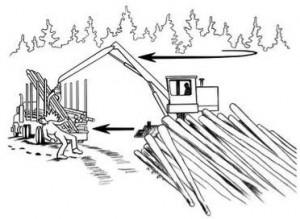BACKGROUND: On a late summer afternoon in the South, a forester was checking harvest contract compliance at a logging operation. Weather conditions were good.
PERSONAL CHARACTERISTICS: The experienced forester was in his 50s. He was not wearing any personal protective equipment.
UNSAFE ACTS AND CONDITIONS: The forester checked the loader operator’s load sheet and headed back to his pickup truck, which was parked away from the loader operator’s view. He then remembered he needed to check a cutting line behind the loading site. In a hurry, he walked back along the edge of the log deck, past a log trailer that was being loaded. The forester thought he was far enough away from the knuckleboom loader’s operation, but he misjudged the distance. The loader operator did not realize the forester was still on the harvest site. He swung a load of treelength pine around to load it on the trailer.
ACCIDENT: The upper (small) end of one of the trees in the loader’s grapple struck the forester in the shoulder and knocked him to the ground.
INJURY: The forester suffered a badly bruised shoulder and lost one day of work. He was fortunate that the load did not strike him in the head or more directly.
RECOMMENDATIONS FOR CORRECTION: When visiting a harvesting operation, landowners, forest managers, and others should make the loader operator and crew members aware of their presence. When approaching an area where harvesting machinery is operating, never assume an equipment operator sees you, even if it appears he is looking right at you, until he stops and lowers his blade, boom, or harvester head to the ground and the machine idles down. Resist the temptation to cut safety corners when in a hurry.
Visitors should inform the crew supervisor of plans to walk within the harvest area. Authorized visitors (and on-the-ground logging employees) should maintain a distance of least “twice tree height” (greater distances for machines with rotating disc saws) away from operating equipment and felling operations.
Visitors should always wear hard hats—and sturdy boots, safety glasses, and hearing protection when appropriate. Wearing brightly-colored (blaze orange or bright fluorescent) shirts or vests will improve visibility to machine operators and may even save a life.
 Courtesy of the Forest Resources Association: https://www.forestresources.org/
Courtesy of the Forest Resources Association: https://www.forestresources.org/
